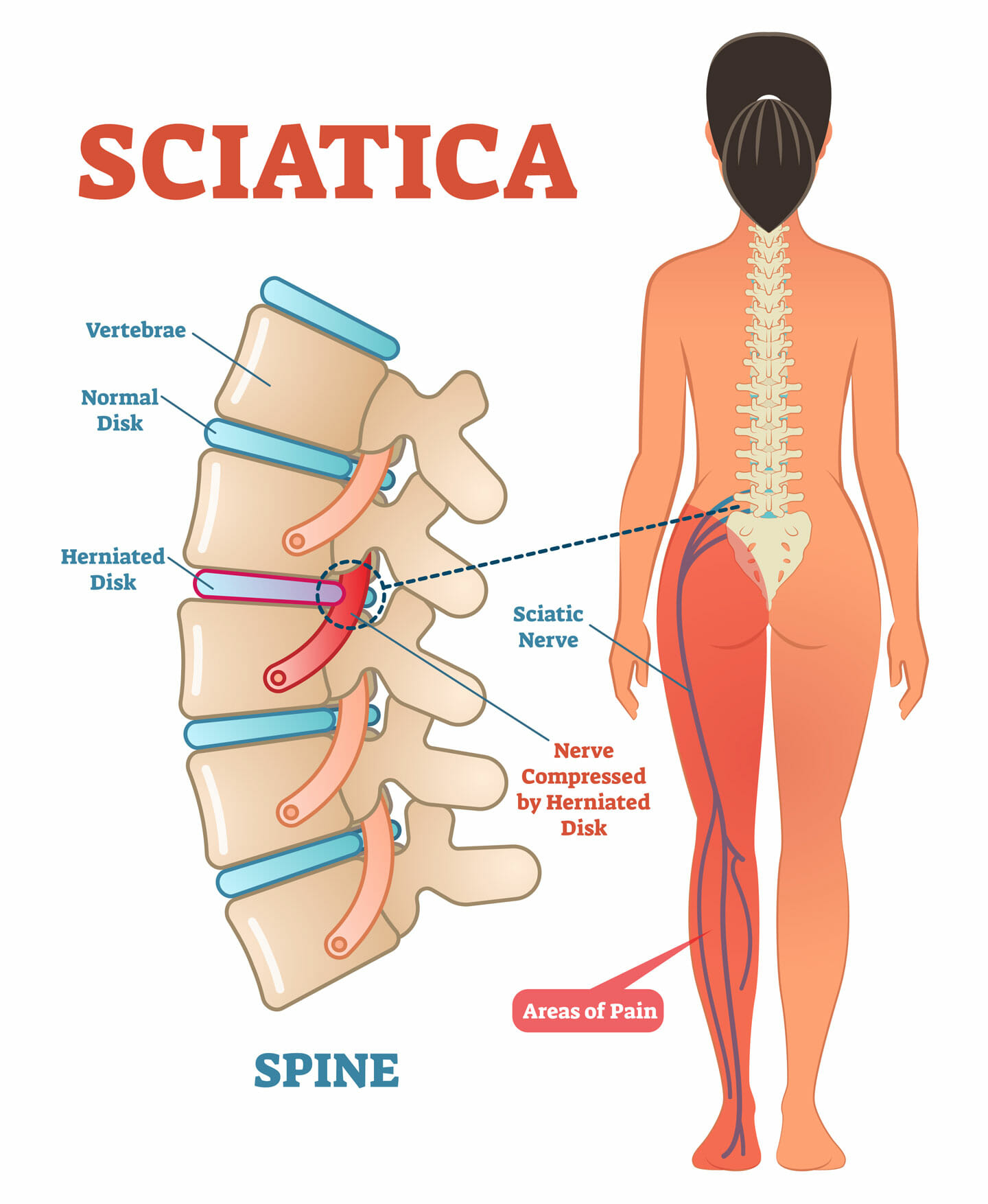Sciatica Treatment

If you’re experiencing sciatica, a condition that causes pain down the thigh and leg associated with compression of the sciatic nerve, you’re likely seeking effective treatment options to alleviate severe pain and improve your quality of life. At Brisbane West Osteopath, we have a special interest in the treatment of sciatica, utilising various approaches to address the underlying causes of your pain and provide relief. In this article, we will answer common questions about how we treat sciatica pain and discuss different treatment methods for your spine.
Sciatica, often characterised by debilitating back pain, leg pain, and numbness, is a condition that occurs when the sciatic nerve, which runs from the lower back down the legs, becomes irritated or compressed, often in the lumbar spine.
In cases of acute sciatica due to a herniated disc, self-care measures such as walking and gentle exercises can provide relief from the pain and improve symptoms.
Sciatica Causes
Sciatica is typically caused by compression or irritation of the sciatic nerve. Common causes include herniated discs, spinal stenosis, degenerative disc disease, and muscle imbalances. In some rare cases, underlying conditions such as spinal tumors or infections can also lead to sciatica. Identifying the cause is essential for developing an effective treatment plan.
Diagnosing Sciatica
To diagnose sciatica, healthcare professionals typically perform a thorough physical examination, reviewing your medical history and conducting specific tests to assess your symptoms and identify potential underlying causes. Diagnostic imaging, such as MRI, may be ordered to visualise the spine, discs, and nerve roots to confirm the diagnosis and guide treatment decisions.
Sciatica, caused by irritation or compression of the sciatic nerve, can be debilitating, often causing severe pain and discomfort. Fortunately, various treatment options are available to alleviate sciatica pain and promote healing for your back pain. Here, we discuss additional approaches and therapies commonly used in sciatica treatment.
What Is The Fastest Way To Help Sciatica?
While there is no instant cure for sciatica, several treatment approaches can help speed up your recovery. A combination of conservative treatments such as gentle Osteopathic techniques, medication, and specific exercises tailored to your condition can help relieve pain and promote healing.
It’s essential to consult with a healthcare professional to develop a comprehensive treatment plan based on your individual needs.
Osteopathic Treatment For Sciatica
Specific Osteopathic techniques to improve pelvic alignment and assist the lumbar spine are a key component of the sciatica treatment we provide. We focus on strengthening the core muscles, improving flexibility, and addressing imbalances that contribute to nerve compression. Through targeted exercises and manual techniques, Osteopathic treatment aims to reduce pain, restore function, and prevent future recurrences.
Our experienced therapists will design a customised treatment program to address your specific needs and guide you through the recovery process.
Conservative Treatments and Alternative Therapies
In most cases, sciatica can be effectively managed through conservative treatments. Alongside physical therapy, other options include medication to alleviate back pain and reduce inflammation, hot and cold packs for symptom relief, and alternative therapies such as acupuncture or chiropractic care. These approaches can be highly beneficial, especially for individuals with chronic pain or who prefer non-invasive treatment options.
Conservative Treatments and Self-Care Strategies
In many cases, sciatica pain can be effectively managed through conservative treatments, such as Osteopathy and self-care strategies. These may include gentle Osteopathic techniques through the lower back and pelvis, specific exercises to strengthen the muscles supporting the spine and improving flexibility, and sometimes taking over-the-counter pain medications to decrease back pain and inflammation. It is important to consult with a healthcare professional to ensure proper implementation of self-care treatments.
Osteopathy and Exercise
Osteopathy plays a vital role in treating sciatica by addressing the underlying causes of the condition. Through a combination of targeted exercises, manual therapy, and specialised techniques, Osteopaths help improve lower back biomechanics, strengthen the core muscles, and alleviate pressure on the sciatic nerve. Regular exercise can promote healing, reduce back pain, and prevent future episodes of sciatica.
Nonsurgical Treatments and Interventional Procedures
In most cases, conservative treatment is enough. In cases where conservative treatments alone do not provide sufficient relief, additional nonsurgical treatments may be considered. These may include epidural steroid injections, which deliver anti-inflammatory medication directly to the affected area, reducing back pain and inflammation. Other interventional procedures, such as nerve blocks or radiofrequency ablation, may be utilised to provide long-term pain relief.
Soft Tissue Techniques
Soft tissue techniques can be a valuable adjunct to sciatica treatment, particularly for relieving muscle tension and reducing back pain. Skilled therapists can apply various techniques to the soft tissues surrounding the sciatic nerve, helping to relax muscles, improve blood flow, and promote healing. By targeting specific trigger points and areas of tension, massage therapy can offer significant relief for individuals with sciatica.
Osteopathic Treatment
At Brisbane West Osteopathy, we have a different way of assessing and treating the pelvis. Improving the pelvic biomechanics improves how the lower back (lumbar spine) functions. We then perform gentle techniques on the lumbar spine to help disc problems recover. We have found this approach very effective in helping patients with disc problems and sciatica to recover well.
When To Seek Medical Attention
While many cases of sciatica can be managed with conservative treatments, it is important to seek medical attention if you experience severe symptoms, such as significant muscle weakness, loss of bowel or bladder control, or progressive neurological deficits. Additionally, if symptoms persist or worsen despite conservative treatment, a healthcare professional can help determine if further evaluation or alternative treatments are necessary.

How Do I Get My Sciatic Nerve To Stop Hurting?
To alleviate sciatic nerve pain, it is crucial to address the underlying cause of the back pain. Osteopathy plays a significant role in treating sciatica, as it focuses on improving pelvic and lower back biomechanics, as well as strengthening the muscles supporting the spine, improving flexibility, and correcting posture. Additionally, walking and core exercises can help reduce inflammation and provide pain relief.
Does Sciatica Ever Go Away?
In many cases, sciatica pain resolves with time and appropriate treatment. By addressing the root cause of the pain and implementing effective treatment strategies, the majority of individuals experience significant relief. This normally takes six weeks, from the first treatment. The duration of recovery varies from person to person, and it’s important to be patient and follow the recommended treatment plan for optimal results.
Is Walking Good For Sciatica Pain?
Engaging in low-impact activities such as walking can be beneficial for individuals with sciatica pain. Walking promotes blood flow, releases endorphins (natural pain-relieving chemicals), and helps strengthen the muscles supporting the spine. However, it is essential to listen to your body and avoid overexertion. If walking exacerbates your symptoms, it’s advisable to consult with a healthcare professional for further guidance.
Exploring Other Treatment Options:
In certain cases, surgery may be considered for individuals with chronic sciatica or when conservative treatments fail to provide adequate relief. Surgical interventions, such as discectomy or spinal fusion, aim to remove the source of compression and alleviate pressure on the sciatic nerve.
However, surgery is rare in patients who follow our treatment and is typically considered a last resort and reserved for specific situations where conservative measures have proven ineffective.
Understanding and Treating Sciatica
Sciatica can cause significant pain and discomfort, but with the appropriate treatment approach, relief is possible. By targeting the underlying causes, such as herniated discs or spinal stenosis, and utilising a combination of conservative treatments, interventional procedures, and core exercises, Osteopaths can effectively manage sciatica and help patients regain their quality of life.
It is essential to consult with a healthcare professional for a comprehensive evaluation and accurate diagnosis before initiating any treatment plan. They can determine the most appropriate course of action based on your specific condition, symptoms, and medical history.
At Brisbane West Osteopathy we aim to diagnose the underlying cause of your pain so we can offer you the most effective treatment. Our goal for each patient? Pain relief that lasts, so you can get on with what’s important.
For effective neck and back pain treatment in Brisbane contact us today.
References
*Chaitow L., Jones R., 2012. Chronic Pelvic Pain and Dysfunction. Churchill Livingstone.
Contact us
Call Us
Email Us
Our Location
Within the Bardon Counselling & Natural Therapies Centre
151 Boundary Rd
Bardon 4065


Brisbane West Osteo is rated as the top Osteopath in Brisbane by The Best Brisbane

